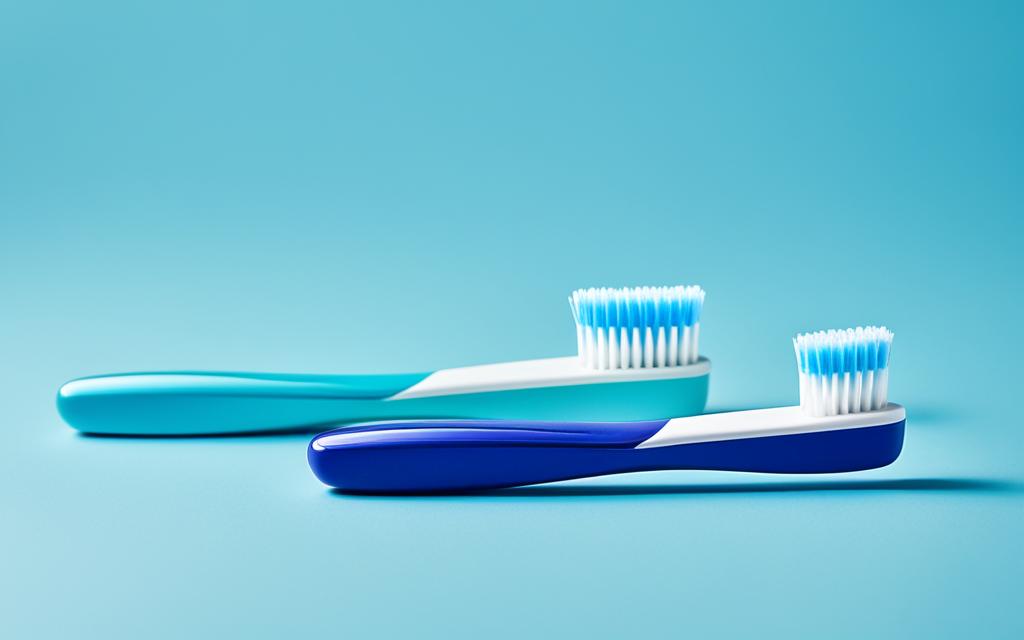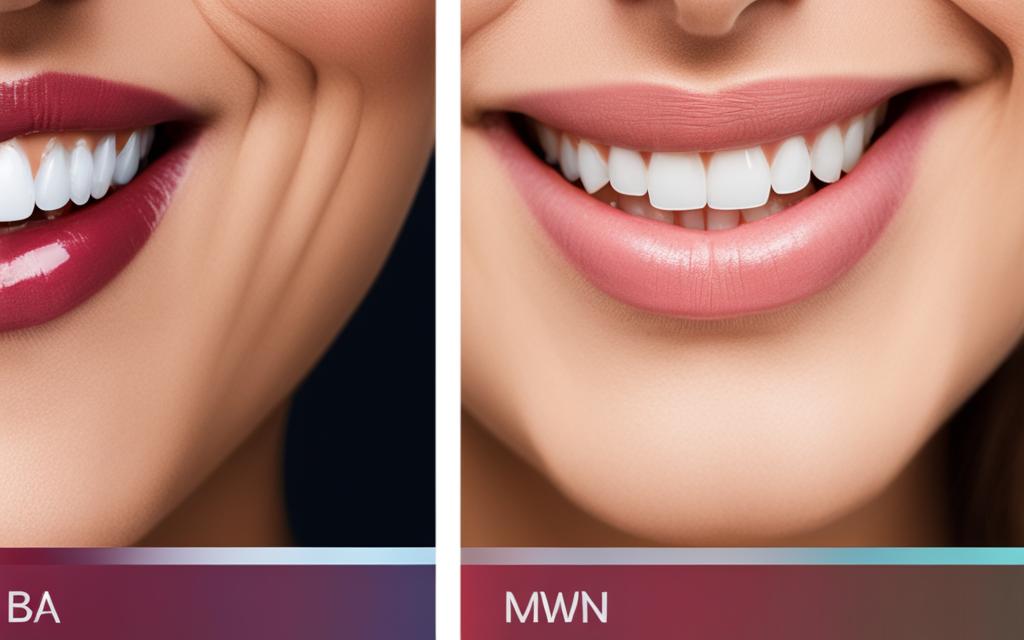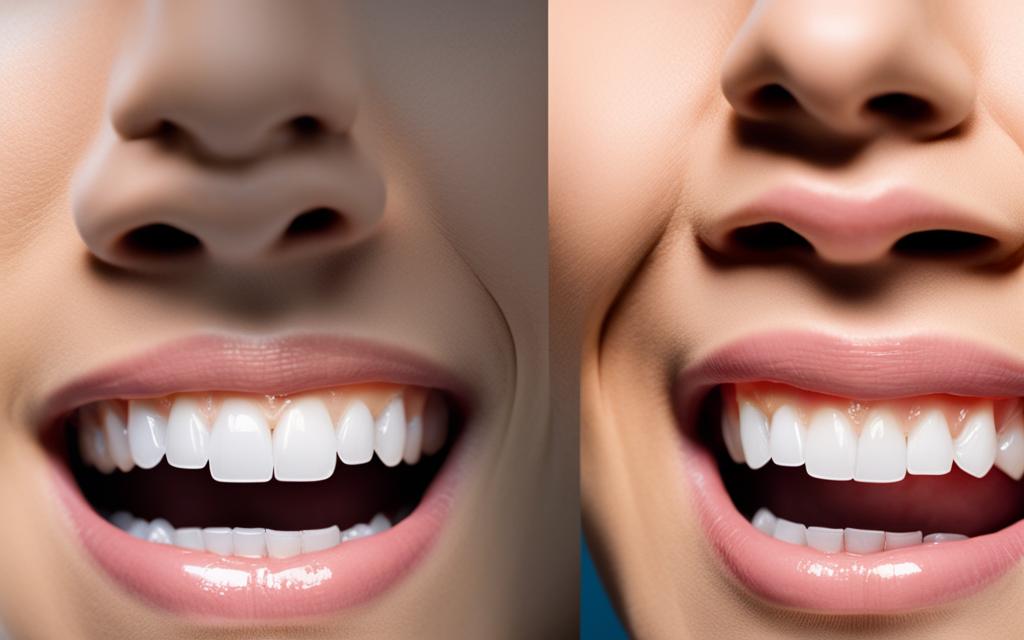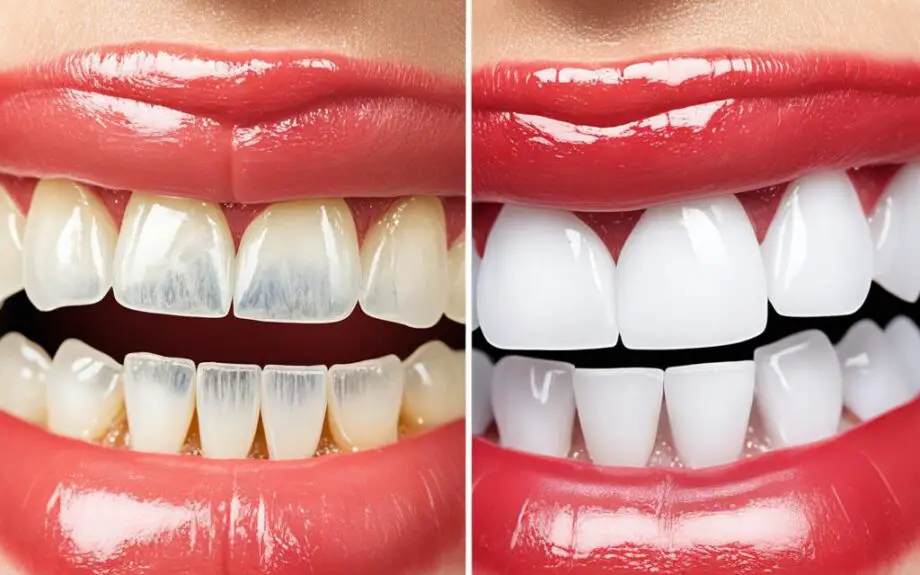If you’re looking for a brighter smile, chances are you’ve heard of teeth whitening strips and gel. But how do you know which one to choose? In this article, we’ll be diving into the differences between whitening strips and gel, their effectiveness, as well as their advantages and disadvantages to help you make an informed decision for your teeth whitening journey.
Whether you’re a first-time whitening user or you’ve tried both products before, it’s essential to understand their unique characteristics to determine which option may be more suitable for you.
Key Takeaways:
- The article compares teeth whitening strips and gel to determine the best choice for achieving a brighter smile
- We explore differences between the two products such as their active ingredients and application methods
- We discuss the effectiveness and potential results of using whitening strips and gel, along with their advantages and disadvantages
- Individual preferences, desired results, and potential sensitivity are essential factors when deciding which option to choose for teeth whitening
- Understanding the pros and cons of teeth whitening strips and gel can help you make an informed decision on which product is best suited for your needs
Understanding Teeth Whitening Strips and Gel
Teeth whitening strips and gel are two popular products that people use to brighten their smiles. While these options offer similar benefits, they differ in terms of their characteristics and composition.
Application methods: Whitening strips consist of thin, flexible pieces of plastic coated with a layer of peroxide-based gel on one side. Users attach the strips onto their teeth and leave them on for a designated amount of time, usually ranging from 20-30 minutes. In contrast, teeth whitening gel requires placing the gel onto a tray that fits over the teeth, which is worn for a specific amount of time.
Active ingredients: Both strips and gel contain peroxide-based compounds such as hydrogen peroxide and carbamide peroxide. However, the concentration of these compounds varies between the two products, with gels typically having higher concentrations.
Which one is better for you? Factors such as individual preferences, desired results, and potential sensitivity can influence which option is most suitable for you. Consult with a dental professional to determine which teeth whitening method is safe and effective based on your unique needs and situation.

“Teeth whitening strips and gel are both effective options for achieving a brighter smile. Understanding the differences between the two can help you make an informed decision about which product is best for you.”
Effectiveness of Whitening Strips
When it comes to whitening your teeth, it’s essential to consider the effectiveness of whitening strips vs gel. Whitening strips have become increasingly popular due to their convenience and affordability. They work by using a thin layer of gel coated onto a flexible strip that molds to your teeth, allowing the whitening agents to penetrate your tooth enamel.
The effectiveness of whitening strips depends on the concentration of whitening agents and the duration of use. Most whitening strips require 30 minutes to an hour of daily usage for up to two weeks. With consistent usage, users can achieve a noticeable difference in the color of their teeth, typically up to six shades whiter.
Users have reported positive results with teeth whitening strips. According to one study, 80% of users experienced an improvement in teeth whiteness after using whitening strips for two weeks. However, results may vary depending on individual factors such as the severity of staining, oral hygiene habits, and the strength of the whitening agents.
It’s important to note that teeth whitening strips may cause temporary tooth sensitivity or gum irritation, especially if overused or applied incorrectly.
The Benefits of Using Whitening Strips
- Easy to use
- Affordable
- Convenient
- Non-invasive
The Limitations of Using Whitening Strips
- May cause sensitivity or irritation
- May not reach all areas of the teeth
- Less customizable than other options, such as whitening gels
Advantages and Disadvantages of Teeth Whitening Strips
Teeth whitening strips are a popular option for those looking to enhance their smile, but like any product, they come with both advantages and disadvantages. Let’s take a closer look at the pros and cons of using teeth whitening strips.
Advantages:
- Convenience: Whitening strips are easy to use and can be done from the comfort of your own home.
- Cost-effective: Compared to other whitening treatments, strips are relatively affordable.
- No mess: Unlike gels, strips are mess-free and won’t leave behind any residue.
Disadvantages:
- Potential sensitivity: Whitening strips can cause tooth sensitivity or even gum irritation in some individuals.
- Limitations in reaching all areas: Strips may not be able to whiten all parts of your teeth, particularly hard-to-reach areas.
- Less customizable: Some may find that strips do not provide the level of customization needed for their specific whitening needs.
Overall, teeth whitening strips can be a great option for those looking for an affordable and convenient way to brighten their teeth. However, it is important to weigh the pros and cons before deciding if they are the right choice for you.

Exploring Teeth Whitening Gel
Teeth whitening gel is another popular alternative to strips that has been known to produce effective results. The gel typically contains hydrogen peroxide or carbamide peroxide, which are the active ingredients responsible for removing stains and discoloration from teeth.
There are two primary application methods for teeth whitening gel: using a tray or brush. The tray method involves filling a custom-fitted tray with the gel and wearing it for a set period of time, while the brush method requires applying the gel directly onto the teeth with a small brush.
The strength of the gel varies depending on the brand and product. Stronger formulas may result in quicker results, but may also increase the risk of tooth sensitivity. It is important to carefully follow the instructions provided and monitor any discomfort during use.
Looking for a teeth whitening product that targets specific areas? Whitening gel may be a suitable option as it can be applied directly to problem areas, allowing for more targeted whitening. However, the gel may not be as convenient as strips as it requires more time and effort to apply and could potentially cause discomfort for those with sensitive teeth.

Dr. Smith, a dental professional at Bright Smiles, recommends using teeth whitening gel as a complement to routine dental cleanings. “Gel provides a deeper and more long-lasting whitening effect,” he says. “However, it should not be used as a substitute for regular dental check-ups and cleanings.”
Overall, teeth whitening gel can be a great option for achieving a brighter smile, but it may not be the most convenient or suitable for everyone. Each individual should consider their personal preferences and consult with a dental professional before deciding between whitening gel and strips.
Pros and Cons of Teeth Whitening Gel
Teeth whitening gel is a popular option for achieving a brighter, more radiant smile. Like any product, it has its advantages and disadvantages that are worth considering before making a purchase.
Advantages of Teeth Whitening Gel
- Customization options: Teeth whitening gel allows for a greater degree of customization in terms of treatment duration and frequency, enabling users to tailor their routine to fit their specific needs.
- Stronger formula: Gel-based whiteners typically contain a higher concentration of whitening agents than strips, which may lead to more noticeable results in a shorter amount of time.
- Longer-lasting effects: While results vary from person to person, teeth whitening gel has been known to provide longer-lasting effects than strips.
Disadvantages of Teeth Whitening Gel
- Potential gum irritation: Whitening gel is applied directly to the teeth and may come into contact with the gums, potentially causing sensitivity and irritation.
- Consistent usage required: Teeth whitening gel requires regular and consistent use to see desired results. Failure to adhere to a routine may result in less noticeable effects.
Overall, teeth whitening gel and strips both have advantages and disadvantages to consider. It is important to evaluate personal preferences and desired results before making a decision.
Conclusion
When it comes to achieving a brighter smile, choosing between whitening strips vs gel can be a difficult decision. Throughout this article, we have explored the differences between these two products, as well as their respective advantages and disadvantages.
Ultimately, the best choice between the two will depend on individual preferences and goals. Whitening strips are a convenient option for those looking for a simple and easy-to-use product. On the other hand, teeth whitening gel offers more customization in terms of application and strength, making it a good choice for those with specific needs or who require a more intense whitening experience.
Regardless of which option you choose, it is important to be consistent and patient in your usage. Both whitening strips and gel can produce impressive results if used correctly over time.
In conclusion, there is no clear winner in the comparison of whitening strips vs gel. Rather, the best choice will depend on individual factors such as sensitivity and desired results. We hope this article has provided you with the information you need to make an informed decision and embark on your teeth whitening journey with confidence.
FAQ
What are the differences between teeth whitening strips and gel?
Teeth whitening strips are thin, flexible pieces of plastic coated with a layer of whitening gel. They are designed to be placed directly onto the teeth, allowing the gel to work on the enamel. Whitening gel, on the other hand, is a gel formula that is typically applied using a brush or tray. The gel is left on the teeth for a certain amount of time to achieve the desired whitening effect.
Which is more effective, teeth whitening strips or gel?
The effectiveness of teeth whitening strips and gel can vary depending on several factors, such as the concentration of whitening agents and the duration of use. Some studies suggest that both methods can deliver noticeable whitening results, but gel products may have a slight edge in terms of overall effectiveness.
What are the pros and cons of using teeth whitening strips?
Teeth whitening strips have some notable advantages, such as convenience and ease of use. They can be applied at home and are generally more affordable than professional whitening treatments. However, strips may be less effective at reaching all areas of the teeth, and some users may experience sensitivity or gum irritation.
What are the advantages and disadvantages of teeth whitening gel?
Teeth whitening gel offers certain benefits, such as the ability to customize the application and concentration of the gel. It can be more effective in reaching all areas of the teeth compared to strips. However, gel products may require consistent usage over a longer period to achieve desired results, and some individuals may experience gum irritation or sensitivity.
Which option, whitening strips or gel, should I choose?
The choice between teeth whitening strips and gel ultimately depends on your personal preferences and specific needs. If convenience and affordability are important to you, whitening strips may be a suitable option. If customization and potential for more noticeable results are your priorities, teeth whitening gel may be the better choice. It’s recommended to consult with a dental professional to determine which option would be most effective and safe for your individual teeth whitening journey.
